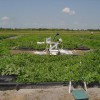
Flooding is a major risk for commercial vegetable production in south Florida, especially in the south Dade County area. Flooding causes oxygen deficiency, or hypoxic stress, causing the plants to produce less energy. This shortage in energy prevents the absorption of nutrients like nitrogen, phosphorous, and potassium. This four-page fact sheet discusses several different management practices for overcoming flood damage, including the use of nitrogen and potassium fertilizers, oxygen fertilizers, growth regulators, and fungicides. Written by Goudong Liu, Yuncong Li, and Xiangju Fu, and published by the Soil and Water Science Department.
http://edis.ifas.ufl.edu/ss425
Tag: Water Management for Vegetable Production
Water Use for Seepage-Irrigated Watermelon with Plastic Mulch in Florida
 In Florida, watermelon is an important crop that accounts for a significant part of the state’s agricultural water use. Depending on the type of production system and climate, the water use of this crop can vary. In Florida, watermelon is predominantly grown on raised plastic-mulched beds. To develop improved water management and allocation plans, accurate water use estimates for watermelon are needed. Seepage irrigation under plastic mulch is a common production system used to produce watermelon in south and northeast Florida where the water table is shallow. Plastic mulch alters the rainfall entry and soil temperature of the raised beds and can significantly affect evapotranspiration. As there is no information on seepage-irrigated watermelon grown on plastic mulch for subtropical Florida, this 4-page fact sheet summarizes the results from a crop water use study for the seepage-irrigated watermelon in south Florida. Written by Sanjay Shukla and Niroj K. Shrestha, and published by the UF Department of Agricultural and Biological Engineering, August 2014.
In Florida, watermelon is an important crop that accounts for a significant part of the state’s agricultural water use. Depending on the type of production system and climate, the water use of this crop can vary. In Florida, watermelon is predominantly grown on raised plastic-mulched beds. To develop improved water management and allocation plans, accurate water use estimates for watermelon are needed. Seepage irrigation under plastic mulch is a common production system used to produce watermelon in south and northeast Florida where the water table is shallow. Plastic mulch alters the rainfall entry and soil temperature of the raised beds and can significantly affect evapotranspiration. As there is no information on seepage-irrigated watermelon grown on plastic mulch for subtropical Florida, this 4-page fact sheet summarizes the results from a crop water use study for the seepage-irrigated watermelon in south Florida. Written by Sanjay Shukla and Niroj K. Shrestha, and published by the UF Department of Agricultural and Biological Engineering, August 2014.
http://edis.ifas.ufl.edu/ae510
Water Use for Seepage-Irrigated Pepper with Plastic Mulch in Florida
 Bell pepper (Capsicum annuum) is an important crop for Florida and accounts for a significant fraction of its agricultural water use. Most of it is produced in south Florida, where the water table is shallow. Seepage irrigation is one of the most common systems used in south Florida for growing plastic-mulched vegetable crops, including bell pepper. Compared with an open field production, covering the soil with impermeable plastic reduces soil evaporation and increases transpiration. This 3-page fact sheet summarizes the results from a crop water use study for the seepage-irrigated pepper in south Florida.
Bell pepper (Capsicum annuum) is an important crop for Florida and accounts for a significant fraction of its agricultural water use. Most of it is produced in south Florida, where the water table is shallow. Seepage irrigation is one of the most common systems used in south Florida for growing plastic-mulched vegetable crops, including bell pepper. Compared with an open field production, covering the soil with impermeable plastic reduces soil evaporation and increases transpiration. This 3-page fact sheet summarizes the results from a crop water use study for the seepage-irrigated pepper in south Florida.
Written by Sanjay Shukla, Niroj Shrestha, and Fouad H. Jaber, and published by the UF Department of Agricultural and Biological Engineering, August 2014.
http://edis.ifas.ufl.edu/ae509
Solutions for Managing Wastewater in Florida Tomato Packinghouses (SL372/SS573)
 A large amount of wastewater is produced in Florida's packinghouses during the cleaning and sanitizing of tomatoes. High transportation costs for off-site disposal and strict surface water discharge regulations are critical issues associated with the management of this wastewater. This 4-page fact sheet provides solutions for increasing the reuse of wastewater in tomato packinghouses in Florida. Written by Gurpal Toor, Maninder Chahal, and Bielinski Santos, and published by the UF Department of Soil and Water Science, August 2012.
A large amount of wastewater is produced in Florida's packinghouses during the cleaning and sanitizing of tomatoes. High transportation costs for off-site disposal and strict surface water discharge regulations are critical issues associated with the management of this wastewater. This 4-page fact sheet provides solutions for increasing the reuse of wastewater in tomato packinghouses in Florida. Written by Gurpal Toor, Maninder Chahal, and Bielinski Santos, and published by the UF Department of Soil and Water Science, August 2012.
http://edis.ifas.ufl.edu/ss573
Cultural Practices for Vegetable and Small Fruit Crops: Using Kaolin Clay to Reduce Sprinkler Irrigation for Strawberry Transplant Establishment (HS1188)
Because of the current limitations on water usage for strawberry growers in the Plant City area of Hillsborough County, researchers at the UF/IFAS Gulf Coast Research and Education center have been looking for inexpensive ways to reduce the amount of sprinkler irrigation in strawberry production. This 3-page fact sheet presents research results on the effect of kaolin clay application on sprinkler irrigation volumes applied to newly transplanted strawberries. It was written by Bielinski M. Santos, Teresa P. Salame-Donoso, Craig D. Stanley, Alicia J. Whidden, Crystal A. Snodgrass, and Mary B. Henry, and published by the UF Department of Horticultural Sciences, December 2010.
http://edis.ifas.ufl.edu/hs1188